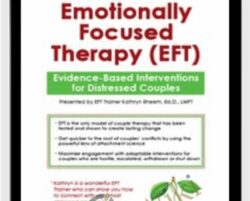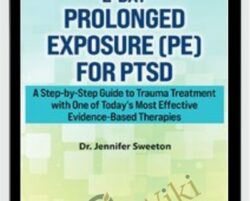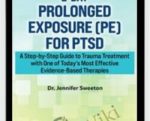Prolonged Exposure (PE) is one of the most effective and most studied therapies for PTSD available. It holds the strongest recommendation as a treatment for PTSD in every clinical practice guideline and allows clinicians to get straight to the heart of the problem for trauma survivors…the memory of what happened.But you worry that revisiting these memories will lead to panic, symptom exacerbation and client dropout. And you fear that you aren’t prepared to handle a client’s distress. How can you overcome these concerns to bring this gold standard trauma therapy into your practice?This 2-day seminar training, is a step-by-step guide to utilizing PE therapy in your practice, with the tools, techniques, case studies and clinical insights you need to treat a variety of populations and improve outcomes.Taught by internationally recognized trauma expert Dr. Jennifer Sweeton, this course will show you how the clinical skills and instincts you already have can make PE more accessible and applicable than you ever thought possible. Attend and discover how you can:Set the stage with clients to decrease avoidance and reduce the chances of dropoutGet specific guidance on structuring PE sessionsHelp clients modulate their distress and manage their emotions with simple techniquesConfidently conduct imaginal and in vivo exposureEffectively work with “hot spots” – the most distressing aspects of your clients’ traumatic memoriesAddress specific therapeutic situations including panic, anxiety, anger and irritabilityDon’t leave one of the most effective trauma therapies out of your therapeutic toolbox!Purchase today!Determine how the symptoms of PTSD impact client functioning and influence clinician choice of intervention.Investigate how Emotional Processing Theory and the process of habituation is connected to the clinical effectiveness of Prolonged Exposure Therapy.Assess how psychoeducation about common reactions to PE therapy can be used by clinicians to establish client expectations for treatment and reduce the incidence of dropout.Determine how motivational interviewing techniques can be used in session to reduce negative feelings about exposure treatment.Determine how breathing retraining can be taught during the first session of the PE protocol to help clients manage immediate distress.Evaluate how clinicians can work with clients to determine the index trauma with clients who have experienced multiple traumas, so they can work with the one most likely to be causing the majority of symptoms.Utilize imaginal exposure to reduce the intensity and frequency of PTSD symptoms in clients.Utilize in vivo exposure to help clients approach and increase participation in situations that are safe, but they have been avoiding as a result of related trauma.Evaluate how clinicians can work on “hot spots” rather than having the patient retell his entire narrative to more efficiently reduce the intensity of associated symptoms.Employ homework assignments that complement in-session exposures by enhancing key change processes.Assess risks and contraindications to the use of Prolonged Exposure Therapy to determine which clients should not be treated with PE.Revise exposure techniques and duration depending on the client’s needs and the rate of progress.Get 2-Day Prolonged Exposure (PE) for PTSD: A Step-by-Step Guide to Trauma Treatment with One of Today’s Most Effective Evidence-Based Therapies – Jennifer Sweeton, Only Price $175Prolonged Exposure and the Emotional Processing TheoryEmotional Processing TheoryWho PE was designed forResearch supporting PE as an evidence-based therapy for PTSDComparison to other treatments for PTSDRisks and contraindicationsDiagnosing PTSD and other Trauma (or Stressor) Related DisordersDSM-5™ criteriaCultural considerationsBrain Science of Trauma and Exposure TherapyAmygdalaHippocampusInsulaCortical areasAssessment/Screening ToolsPrimary Care PTSD ScreenPCL-5IES-RCAPS-5Trauma Treatment RoadmapBottom-up vs top-down approachesStabilization and groundingWhere PE fits into the roadmapPreparing Your Clients for PEAssessing for readinessMotivational interviewing techniquesPsychoeducation about trauma processing and PETherapeutic allianceThe PE Protocol: Essential Components and Step-by-Step TrainingSession 1Trauma interviewIdentifying the index traumaBreathing retraining techniqueSession 2Common reactions to traumaPsychoeducation about in vivo exposureIn vivo exposure fear hierarchyHomework assignments related to in vivo exposureSessions 3 and BeyondImaginal exposure to the traumatic event: step by stepSUDS, symptom monitoring, and stabilizationManaging hot spotsProcessing of the exposureIn vivo exposure progressFinal SessionFinal assessmentProgress reviewRelapse preventionDetermining next steps in therapyHow to Deal with Avoidance and AnxietyOver engagement/under engagementPanic/anxietyAngerAvoidanceHomework compliancePE ModificationsExtending session length and/or increasing/decreasing frequencyTBIMoral injuryOther modificationsIntegrating PE with Other Treatment ModalitiesEMDRCognitive Processing TherapyOther cognitive behavioral approachesGet 2-Day Prolonged Exposure (PE) for PTSD: A Step-by-Step Guide to Trauma Treatment with One of Today’s Most Effective Evidence-Based Therapies – Jennifer Sweeton, Only Price $175Tag: 2-Day Prolonged Exposure (PE) for PTSD: A Step-by-Step Guide to Trauma Treatment with One of Today’s Most Effective Evidence-Based Therapies Review. 2-Day Prolonged Exposure (PE) for PTSD: A Step-by-Step Guide to Trauma Treatment with One of Today’s Most Effective Evidence-Based Therapies download. 2-Day Prolonged Exposure (PE) for PTSD: A Step-by-Step Guide to Trauma Treatment with One of Today’s Most Effective Evidence-Based Therapies discount.
 Freelancing Freedom Masterclass – Brad Hussey
₹22,410.00
Freelancing Freedom Masterclass – Brad Hussey
₹22,410.00
 Emotionally Focused Therapy (EFT): Evidence-Based Interventions for Distressed Couples – Kathryn Rheem
₹13,778.00
Emotionally Focused Therapy (EFT): Evidence-Based Interventions for Distressed Couples – Kathryn Rheem
₹13,778.00
2-Day Prolonged Exposure (PE) for PTSD: A Step-by-Step Guide to Trauma Treatment with One of Today’s Most Effective Evidence-Based Therapies
₹28,386.00





